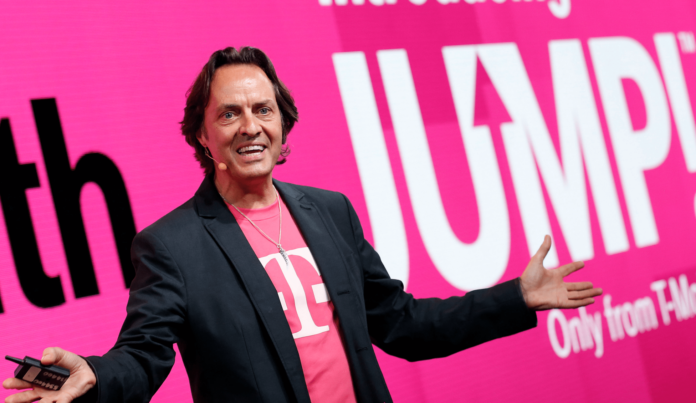Spectrum gains from 600 MHz auction will let T-Mo “compete in every single corner of the country”
T-Mobile US continued its streak of strong quarterly results, adding 1.1 million total net customers to its network and reporting 11% year-over-year growth in both total revenues and service revenues.
“We spent the last four-plus years fighting for consumers and forcing a stupid, broken, arrogant industry to change,” Legere said. “Customers have responded, and this has yielded results beyond even our own expectations.”
Of the 1.1 million total net additions, 914,000 were postpaid subscribers; 798,000 of the devices activated on those postpaid accounts were phones. T-Mobile US added 386,000 prepaid subs through its MetroPCS brand, and CEO John Legere said that average revenue per user for prepaid rose 2.5% year-over-year to $38.53. T-Mobile US-branded, postpaid phone ARPU was $47.53 for the quarter, and the operator indicated that that statistics to be “generally stable” for full-year 2017 compared to last year. T-Mobile US reported postpaid phone churn of 1.18%. The carrier ended the quarter with a customer base of 72.6 million, and it was T-Mobile’s 16th consecutive quarter of adding more than 1 million total net additions.
In terms of revenues, T-Mobile US had service revenues of $7.3 billion, up 11% year-over-year. Total revenues were also up 11% from the same period last year, to $9.6 billion. Net income was $698 million, up 46% year-over-year.
“In a quarter when we forced everyone to follow our move to unlimited, T-Mobile kicked a**,” Legere said on the quarterly results call. Never one to shy away from a chance to deliver a slam to a competitor, Legere noted that Verizon reported last week that it lost around 300,000 postpaid phone customers during the first quarter. “That’s really got to be embarrassing after all that mic-dropping,” he snarked, in reference to Verizon’s ad campaign around its new unlimited offer launched in mid-February — which Verizon credited for nudging the carrier into positive customer numbers for the quarter.
T-Mo expects 600 MHz handsets in time for 2017 holiday season
In discussing the results of the recently closed 600 MHz auction, T-Mobile executives indicated that the carrier quadrupled its low-band holdings and that initial deployment of the spectrum will start this year. The carrier expects that handsets with 600 MHz support will be on the market in time for the 2017 holiday season.
“We secured a nationwide footprint that will enable us to bring low-band spectrum to consumers across every single inch of this country,” Legere said. “This is a game-changer for T-Mobile and sets the stage for us to continue our momentum moving forward.”
CTO Neville Ray said that T-Mobile US plans to launch the new low-band spectrum first in areas where it doesn’t already have low-band holdings launched, and that the carrier is “running very, very hard and we actually are already into pre-deployment phases in some parts of the country.”
According to a post-auction report complied by Allnet Insights & Analytics, T-Mobile US went into the auction with a nationwide average of eight megahertz of low-band spectrum and came out with a nationwide average of 41 megahertz of sub-1 GHz spectrum holdings with a $7.9 billion price tag. T-Mobile expects to have access to at least 10 megahertz of the 600 MHz spectrum, covering more than 1 million square miles, during 2017.
Ray also said on the quarterly call that the Samsung Galaxy S8 is T-Mobile US’ first handset to support LTE in unlicensed spectrum at 5 GHz, and that in a few locations around the country, the carrier is “starting to turn up LTE-U.” Although there are still outdoor tests and trials ongoing, he added, T-Mobile US expects to continue deploying LTE-U this year and into the near future. T-Mobile US’ has indicated that its LTE-U plans involve the use of 20 megahertz of unlicensed spectrum in the 5 GHZ band to provide additional LTE capacity.

